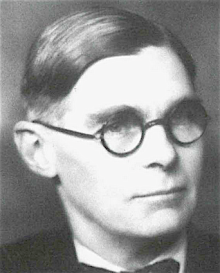
Herbert Collins was born in Hornsey, Middlesex, [now London], England on 2 February 1885. His father, William Jefferies Collins (1856-1939), was a speculative builder, and like him, Herbert Collins initially worked in the building trade after leaving school. At the same time he took evening classes in architecture and the history of architecture under Banister Fletcher, obtaining University of London certificates of merit for courses held between 1914 and 1919 at the British Museum, the Victoria and Albert Museum the Central School of Arts and Crafts in London. He also attended courses part-time at the Architectural Association Schools in London, where he obtained the 3rd year certificate in 1919. During these years he assisted his father in building several houses, some of which he designed himself. The first houses designed by Herbert Collins were on Rockfield Avenue, Muswell Hill (1906-11), one of which, no. 31, he lived in.
In 1921 he passed the entrance examination of the Society of Architects and in 1925 was elected a Licentiate, and then the, following year, an Associate of the Royal Institute of British Architects (ARIBA).
While training as an architect Colllins became enthusiastic about the Garden City movement and in 1924 was appointed a director of the Welwyn Garden City Company.
Collins had plans to create a Garden Suburb in Southampton to where his father had moved in 1911, however, nothing came of the scheme. Nevertheless, in 1922, with his wife, Anne, he moved to Southampton, and settled at 11 Brookvale Road, which was one of the first houses he built on the Uplands estate in the Highfield area of the town. He subsequently designed many more houses on the estate over the next 14 years, including 38 Brookvale Road, the second house he built for himself on the road.
Other architectural works by Collins included Bassett Green Estate, which occupied Ethelburt Avenue and parts of Bassett Green Road and Leaside Way; the Congregational Church on Chandler's Ford, Hampshire, built in 1929; Swaythling Methodist Church, a neo-Georgian church [now a gurdwara] built in 1932; and the Orchards Way estate in West End, Hampshire, designed in 1936 and built over a number of years.
In 1925 Collins co-founded the influential Swaything Housing Society in Southampton which was set up with the purpose of providing good quality, low rent housing.
In c.1930 John Geoffrey Birkett (1902-?) joined Collins in partnership as Herbert Collins & Birkett. Birkett worked primarily as a planner whilst Collins focused more on the design side of the firm. The partnership was dissolved in c.1939. In 1940 Collins was elected a Fellow of the Royal Institute of British Architects (FRIBA) and in 1941 was made a Fellow of the Royal Town Planning Institute.
In 1945 Collins formed a partnership with J. Norman Calton who had formerly worked with him as his assistant. They remained in partnership until 1956. Collins never really retired and continued to work part-time until his 91st year.
Collins had offices at 30 Portland Street, Southampton from 1927 to 1935; 32 Carlton Crescent, Southampton from 1935 to 1975. He died in 1975.
‘Restoration of Bitterne Manor House, Southampton, and its conversion into flats’. Official Architecture & Planning September 1955 pp. 473-475 [Architect: Herbert Collins]
Williams, Robert. Herbert Collins, 1885-1975: Architect and Worker for Peace. Southampton: Paul Cave Publ./City of Southampton Society, 1985